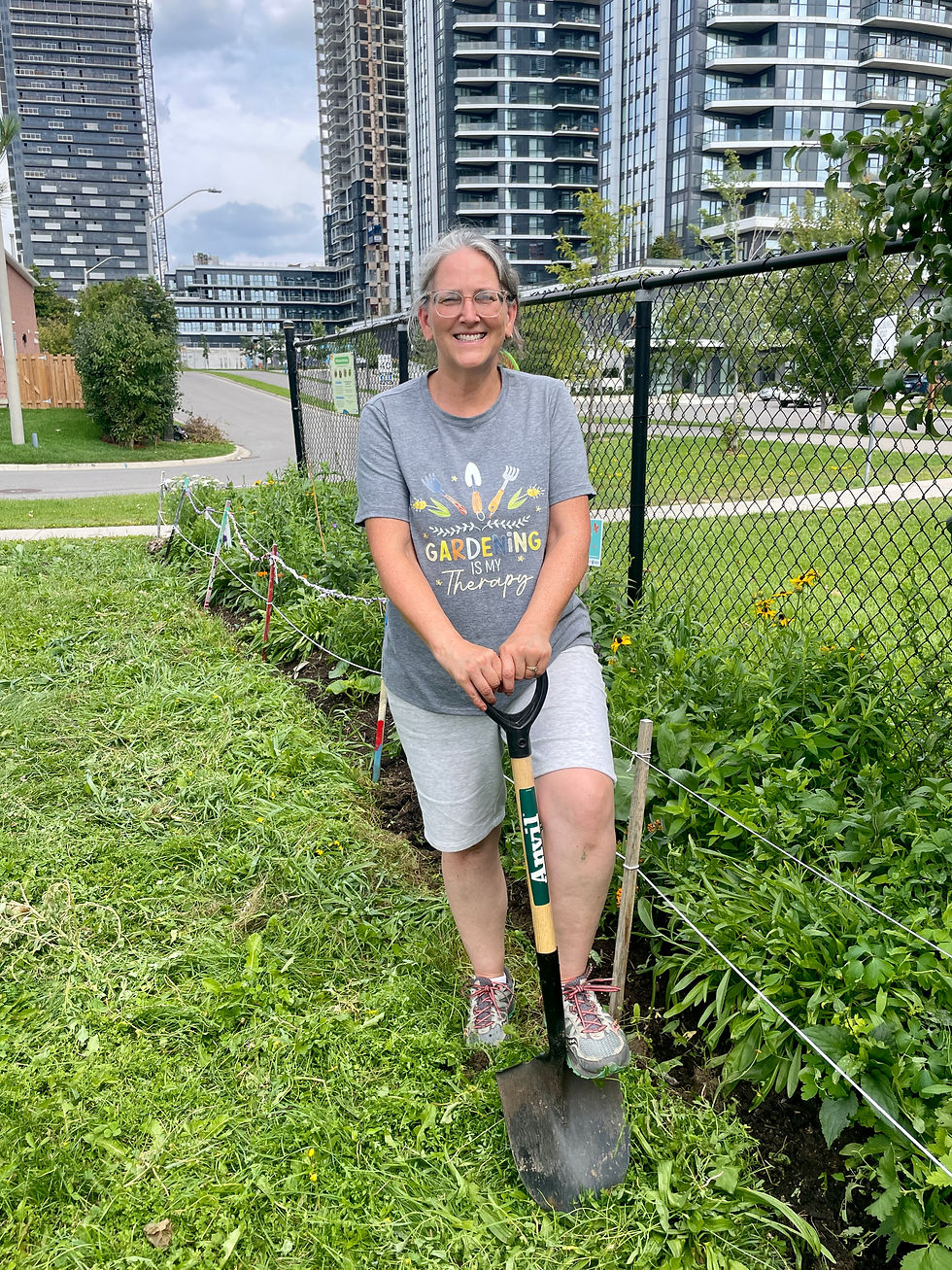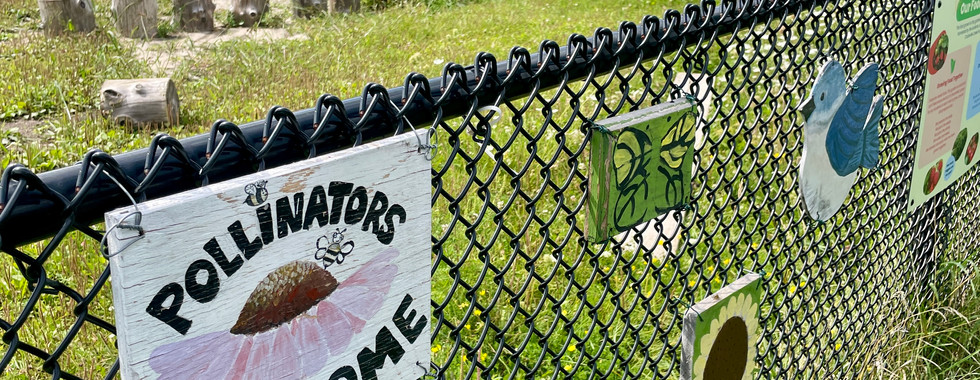Nurturing the Love of Nature
- Jeanne McRight
- Aug 29, 2024
- 5 min read
by Heather Raithby Doyle
Meet Blooming Boulevards member Jennifer Sanderson, a music teacher who shares her love of gardening and the outdoors with her students at Cooksville Creek Public School. Along the way, the schoolyard gets transformed, and the community grows around the project. Although she retires this year, the seeds she planted - both literally and figuratively- will continue to grow for years to come. She shares her thoughts on how she incorporates nature into the school experience.

As a child “I spent my summer in a creek, and came home for dinner when my mom yelled for us,” Jennifer recalls. “One thing we’re finding is that kids aren’t as familiar exploring in nature, ….. I became aware that our kids, for good reasons, come from places and spaces in history where nature is to be feared a little bit.”
She gestures to the highrise apartments around the school. “A lot of our students don’t have backyards, so there’s not a lot of space to garden…They’re city kids.”
“How do we nurture a love of nature from kindergarten or even younger,” she muses. “What’s the effect on a child when they remember rubbing those flowers, learning how to water at the bottom of the plant, look for those bugs, they’re good, they’re our helpers. That might change a generation.”
THE GARDENS

Schoolyards are utilitarian places, not known for their gardens. But towering sunflowers in the Cooksville Creek Public School’s raised planter beds are your first clue that this is not your average sterile schoolyard (although there is plenty of that as well). Goldfinches flit around to eat the seeds. A swallowtail butterfly hovers. On this late- summer afternoon, there is a diversity of plants thriving in the heat, from Mexican beans to eggplants to tomatoes and basil. As we chat, Jennifer uses a spade to dig up a perfect potato. A student passing by is gifted several sunflower heads to feed birds from his balcony.
Building these school gardens was a hands-on learning experience for teachers and students. Teachers assembled the raised beds. At recess the kids, Jennifer says, clamoured to take part. Bucket by bucket, the students volunteered to move a “mountain” of donated mulch (thanks City of Mississauga!) and decided on how to plant the vegetables and flowers. The kids told Mrs Sanderson they were proud of themselves for doing hard work.
“The real hope is the families will continue to take an interest. The teachers won't always be here but the community will.”
In June 2024 the school put in a Blooming Boulevards garden with 250 donated plants. “Jeanne and her husband came and they were so encouraging. They said: ‘With the help of some kids you can do this in an afternoon!’” It did take a little longer, admits Jennifer but with student families watering, and tending the garden this summer, and keeping in touch with each other through a WhatsApp group, the Blooming Boulevards garden is officially thriving. (We can’t wait to check back and see what it looks like next year!)
The new pollinator garden at Cooksville Creek PS was enabled by 250 native plants donated from Blooming Boulevards.
EDUCATIONAL IMPACT
Cooksville Creek Public School is designated by the Peel District School Board as an Eco School. Jennifer credits support from outgoing Principal Laila Culbert, calling her a “waymaker, not a gatekeeper” in helping pursue that designation. The school has held that status for three years, winning the Gold Achievement in 2021-2022, Platinum in 2022-2023, and 2023-2024.
The no-mow zone, pollinator beds, food garden, food cycling program, seed saving, and cooking from the garden are just some of the initiatives that helped the school gain accreditation. And there are many others: Kids build pollinator hotels and bug snugs. Painted signs decorate the fence to educate about the value of pollinators.

Nature gets woven into the curriculum in endless and inventive ways to receive this designation. Jennifer’s music class writes songs about trees. Water stored in rain barrels becomes a starting point for conversations about water and “how we stand up for Indigenous communities that don’t have clean drinking water.” As part of the soil curriculum in Grade Three, students see firsthand how an indoor worm composter turns their apple cores and banana peels into compost for the garden.
A Graduate Grove celebrates each graduating year with a planted tree, and fruit trees provide a lesson on how nature feeds us and the birds. Don’t we all wish we went to a school like that?
It’s time to discard the fear of not knowing enough. “We don’t need a few people doing everything perfectly. We need lots of people doing things the best they can. A little progress in each person’s hands can make a huge difference."
During our interview, a Grade Five student stops by to walk around the plants and say hello to his former teacher. What does he think of the garden? “I like all the beautiful scenery. I think it’s pretty cool we can actually grow food here,” he says. “But it’s sad that people come and destroy our plants.”
Uh, oh. It turns out a few people have been sneaking over and helping themselves to the garden’s bounty, wiping out plants like the kale and broccoli before they even get a chance to grow.
It’s frustrating. But even this setback is a learning opportunity: “We talk about how there can be an energy exchange and reciprocity. If you want to take some tomatoes, what do you have to offer? If you enjoy the flowers, come and take some time to weed around the flowers so they will stay. It’s been an opportunity to teach about neighbourliness as well as the fact we have to take action if we want to see a change,” says Jennifer.
COMMUNITY ENGAGEMENT
Community involvement is key to success
“One of the big lessons I’ve learned is to ‘invite people in' to make decisions. Choose plants that connect with their family, do the activities that connect to their classroom for the teachers, and give choice and voice to the kinds of things the kids like to do. Surprise kids with the harvest, and what they can make with the harvest. Invite families, kids, teachers, politicians to see what we are doing and be part of it, share the work, and share the wealth of gardening,” says Jennifer. She also networks with groups like Seeds of Diversity, Blooming Boulevards, Peel Region, the City of Mississauga, Evergreen Brick Works and more.
Another lesson learned? It’s time to discard the fear of not knowing enough. “We don’t need a few people doing everything perfectly. We need lots of people doing things the best they can. A little progress in each person’s hands can make a huge difference."
And to those kids who are still a bit afraid of wild things, who shriek when they see something move? Jennifer says this: ”At the final assembly, as I was saying goodbye, “I said, will you do one thing for me? Don’t scream at nature. Talk to nature, explore it, step away from it if you are concerned, but you don't need to scream. It wants to live too.’”
Jennifer’s vision for incorporating nature into the school experience extends beyond her tenure at the school. “The real hope is that the families will continue to take an interest. The teachers won't always be here but the community will.” If so, the gardens will continue to bloom and grow and be a vibrant part of the neighbourhood. Jennifer’s impact in Mississauga, both as an educator and her love of nature, will be felt for years, if not generations, to come.
Resources
Find out more about the EcoSchools program at https://ecoschools.ca
Ask Blooming Boulevards how we can help your school provide a habitat for pollinators.
Take a free BloomingBoulevards webinar to learn more about native plant gardens













Comments